This week, the re-read heads to Cetaganda, in Cetaganda! The exclamation point in this case is my addition, and not part of the title like in Oklahoma! This book was first published in 1996, appearing on the shelves between Mirror Dance and Memory, but it’s the sixth book in current reading order. At the beginning of the story, Miles and his cousin Ivan are dispatched to represent the Barrayaran Empire at the funeral of the Cetagandan Emperor’s mother. In some senses, the boys are on their Grand Tour, putting the final touches on a galactic education and getting some practice in doing the things the High Vor do. It’s also a neat little mystery—sort of “Sherlock Vorkosigan.”
Sort of. There’s a lot you can say about Miles, but you certainly can’t say that he’s spent any significant time studying exotic poisons or Cetagandan politics. He’s in pursuit of a mysterious missing object, a murderer, and a conspiracy, but unlike most literary detectives, he’s also a fish-out-of-water on Cetaganda. This works because Bujold deploys Ivan to carry most of the fish role. Ivan’s presence is also one of the reasons that Cetaganda makes a logical follow-up to The Vor Game. That book exposed a lot of the relationship between Miles and Gregor. This one does the same for Ivan. We see a lot of Ivan through the series as a whole—he plays a major role in many books and several important moments of crisis—but this is the most sustained time we get to spend with him as readers until Captain Vorpatril’s Alliance. When I first read these as a teenager, they struck me as a series of adventures and not as a multi-volume exploration of Miles’s relationships. They are, of course, both, and now that I see that, I would like to see Miles spend more quality time with Lady Alys.
What better way to dive in to Cetaganda than an enthusiastic cover blurb from the Romantic Times?
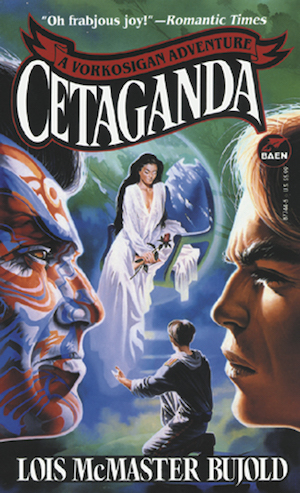
This is the original Baen hardcover edition. It features Miles twice, once in profile and once from the back, kneeling in front of the Haut Rian Degtiar. Miles is squaring off against one of the Cetagandan Ghem. The facepaint is fierce and intimidating, which is an interesting contrast to the sweats and hoodie ensemble Miles seems to be wearing in the background. I believe the artist has taken liberties with his Formal Vorkosigan House Mourning livery. Haut Rian is modelling Cetagandan high fashion, beginning with the force bubble that usually keeps Haut women concealed. I think a force bubble is a must-have accessory for people who attend garden parties in satin-y white bathrobes. It probably also defends the user from forces of nature that can cause difficulties to people with extraordinarily long hair. The artist, Gary Ruddell, also painted covers for some of the other books in the Vorkosigan series, including Mirror Dance, Memory and Komarr. He uses opposing character profiles a lot. This one evokes a superhero team-up comic, which is a nice analogy for the plot here.
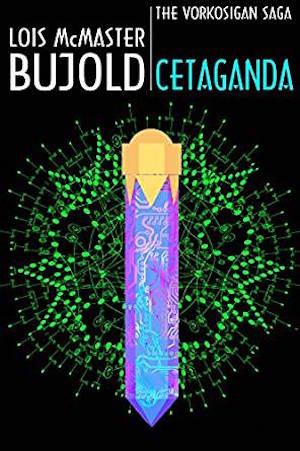
The Kindle edition cover shifts focus from the characters in the book to its McGuffin—the key to the Rose Creche that holds the entire Haut Genome. This version of the seal looks a bit like a test tube and a bit like some kind of computer drive. It also looks a bit like the kind of healing crystal you buy at a Ren Faire, but I think that visual reference is probably unintentional. I like seeing the characters, but I also like the abstract simplicity of this series of covers. On the whole, they demonstrate a clear artistic vision while being true to the contents of the books.
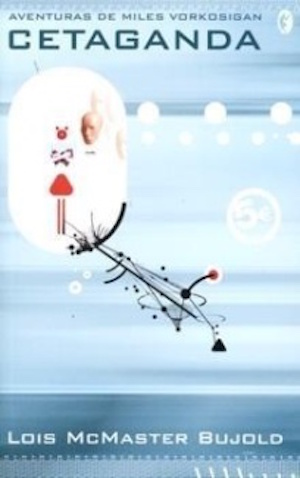
My affection for this version is also an exponent of my love of the abstract, and not a reflection of, just for example, my ability to find an image of this cover at a resolution that allows me to really examine it in detail. The structure in the middle looks like one of Duchamp’s Readymades, and the standing figure—juvenile? skeletal?—inside the bubble suggests that the force shields hide the Haut’s vulnerability. The masks point to the uncertainty surrounding identity that concerns Miles at several points in the story. And, if I’m seeing this correctly, this edition of the book cost five Euros.
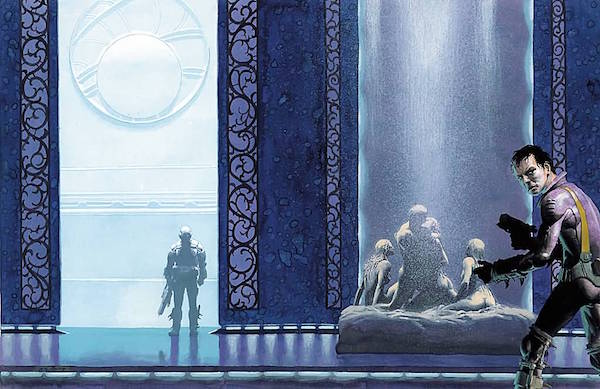
This cover, from the Croatian edition of the book, has abandoned all loyalty to the events of the story. At first glance, it looks like the group of figures just to the right of the center could be gathered around a funeral bier, perhaps discovering the Ba Lura’s corpse. On closer examination, that crowd is mostly nekkid, and not participating in a funeral ceremony for visiting dignitaries. Plus bonus guys with guns. If this represents anything, I think it’s probably Ivan’s rough night at Lord Yenaro’s party. The image certainly conveys a sense of exoticism and danger. It also suggests that the Cetagandan Ghem are into thongs. I take my background information on Cetagandan culture wherever I can find it.
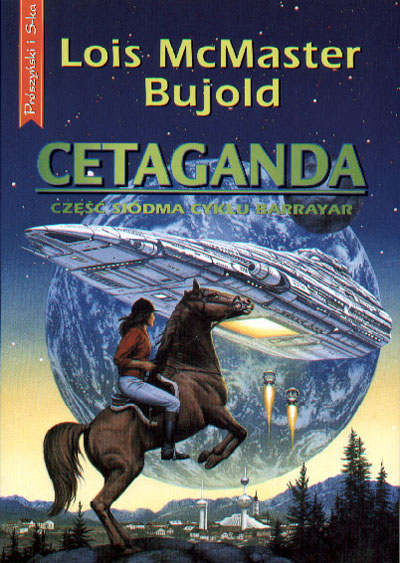
This version of the cover also strays from the plot. Did someone ride a horse in this book and I missed it? I’m only halfway through my pre-reread as I write this. It could have happened. But not, I hope, like this. Come for the book covers, stay for the equitation critique! Although she is demonstrating an otherwise enviable leg position, this rider is on the brink of sliding her feet through the stirrups. This suggests that she is not entirely secure in the tack. She is also using a driving rein. It’s not the same kind of impending disaster as her feet, but it’s not the preferred method of applying a running martingale on a rearing horse. Either our rider is extraordinarily tall, or Cetaganda’s horses are unusually short. Or both! Haut control of the genome may create selection pressures that favor long legs and shrimpy horses.
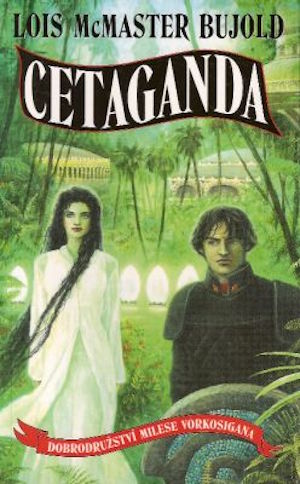
This cover demonstrates the dangers of too much green. The gardens are lush, and the gentle glow of the force bubbles is charming. The architecture in the background evokes the nostalgia of 18th century Neoclassicism, which dovetails nicely with the idea that Miles and Ivan are on the Grand Tour. The Haut Rian Degtiar, however, looks like a zombie. Miles looks alarmed.
Next week—Miles arrives on Cetaganda and is alarmed, although not by the Haut Lady.
Ellen Cheeseman-Meyer teaches history and reads a lot.










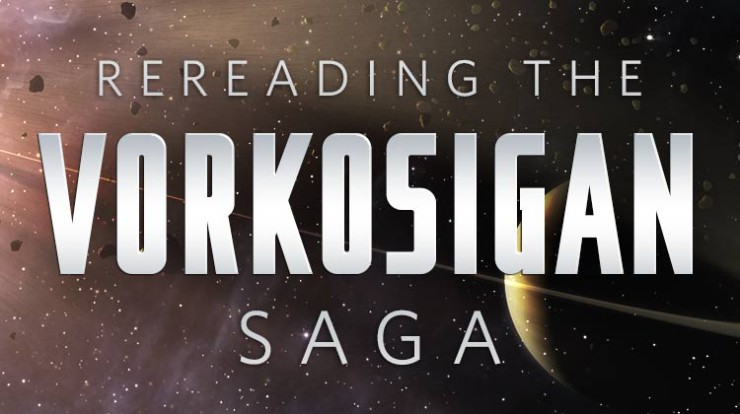
The cover with the horse reminded me a lot of one from another author’s book. I went looking on Google image and Elizabeth Moon’s ‘Winning Colors’ fit the bill. See what you think !
I am in no way trying to suggest that the horse shows up in the book at all (I wish I’d pre-reread it myself so I could say that with more confidence), but the horse cover is kind of cool. It gives the contrast between Barraryar and Cetaganda fairly succinctly – they might be catching up technologically, but Barrayar is still a bit of a backwater, and Cetaganda is this looming threat, that the plucky Miles (I know he’s not the rider, but given the “a man disarmed in a technological war might as well be a woman”, and his disadvantages, it’s fair to have a woman represent him) has to deal with.
Come to think of it, that picture might make a fairly good representation of a scene from the invasion. Except for the part where the large craft looks like it’s supposed to be a space transport, despite being in atmosphere in the picture.
I think this is the only book where Miles has an ordinary commander that he doesn’t get arrested, imprisoned or otherwise blacken their record. It turns out that the mushroom treatment is kinder to his superior officers than getting them involved.
I like the original baen cover. Especially because it coheres to the sequence of covers from that time. It helps unify the series together.
A Miles and Lady Alys adventure would be lovely. Maybe they could visit Sergyar and Miles could deal with having baby sisters. There could also be a parenting plot for Cordelia and Oliver and maybe some fun bits about trying to generate a high society scene on Sergyar. That’d also allow for some Cordelia and Lady Alys screen time, which we don’t get enough of.
*sigh* I’ll add it to the pile of fanfic I’ll never write.
Perhaps that’s because this commanding officer was the first to have the good sense to stay out of a High Vor’s way?
1996? Hard to believe it was twenty years ago. I still remember rushing to Borders on the release date to get my copy.
I seem to recall mention that Barrayaran resistance to the Cetagandan occupation did feature cavalry-versus-starships technological disparities (at least in the early stages). So the equestrian cover might actually make sense symbolically, as a set of iconic images that Cetaganda still evokes in its Barrayaran visitors. In that case, the cover could be showing an economy-sized backwoods equine rather than some haut creation…
That horse cover, as @1 has pointed out, was not painted for Cetaganda. It is also a David Mattingly cover, easy to identify because his spaceships are, well, so Mattingly-esque.
Looking forward to this discussion because this is one of my favorite Vorkosigan books. The Cetagandan culture is absolutely fascinating, and it is nice to see Miles hanging around with Ivan, without the burdens of command weighing him down. It is a nice little cosy mystery, and acts as a “preview of coming attractions” for Miles’ later career as a [spoiler alert] Imperial Auditor.
In a way, the zombie cover, even if it’s also my least favorite, does catch some of what Miles eventually comes to feel about the Haut. There’s a gap that puts them a bit on the uncanny valley side of humanity.
Of course, I think it’s really cool to have an SF culture based on Heian Japan, with the force bubbles taking the place of screens and fans. The artistic sensibility the Heian nobles put into all aspects of daily living, the Haut put into all aspects of daily living and the biological sciences. Whether it’s a genetically designed baby or a biological weapon, it will show elegant sensibilities.
Very funny and apt descriptions. That Croatian cover boggles. Thongs. Lol
the original is pretty informative…. except for the sweats
For the blue Spanish one, here’s a nicer pic:
There are two Russian covers, here’s the better one:
While I like some of the Estonian covers very well, the Cetagandan one isn’t very exciting, so I’ll skip it (just a ship coming out of a wormhole). Sadly, the Japanese one is less exciting as well.
The Korean one is another abstract one:
For French, Caza gives us this:
But the Winning Colours cover is entirely different! The horse is going the other direction!!
It is almost as if the publisher of that edition just slapped any old random sci-fi like cover on they could find. I hope the artist got paid for it!
At least we’re spared the covers where unidentifiable people’s faces fade out into star ships, those happen on several of these books…
Strangely, I don’t think any of these is the same as the cover for the hardcover copy at my library. I seem to remember it as redder. (And my kindle set is three books per package, so I can’t look at those covers.)
Cetaganda was the second Vorkosigan book I ever read, right after Memory. (I was informed you could read them out of order. The person doing the informing either didn’t care about continuity, or underestimated my personal ability to pick the absolute worst place to start a series.) It’s still a favorite, if only because of Ivan coming into his own as a character, and the kitten tree. Oh, the kitten tree… I can’t unsee it.
The test tube one might be my favorite. It’s not perfect, but it captures the Haut Constellation idea and it looks about as toxic as Cetaganda itself. The background is a lot stronger in execution than the actual data stick, though, which looks a bit like someone’s poorly shaded custom content item for a videogame.
SPOILER ALERT
SPOILER ALERT
SPOILER ALERT
What I found most interesting about Cetaganda was how different the Cetagandan and Barrayaran ideas of treason were. On Barrayar, treason is always committed against an individual; you swear an oath to your Emperor or Count, and you serve or betray a person. On Cetaganda, betraying the Emperor is a natural and accepted part of the process; prince-candidates are expected to usurp their Emperor if they get the chance. The only “treasonous” part of the prince-candidate’s plot in Cetaganda was seeking to steal control of the genome from the haut ladies. In a sense, his real crime was interfering with the haut experiment, subordinating the greater purpose of haut genetic destiny to his individual power play.
@13 dptullos – Yes. To the Haut the world is not a stage, the world is a laboratory, and the Cetas are all lab rats. But you must not interfere with the Experiment.
The rest of humanity are just part of the lab environment, the maze where the lab rats are tested. The inclusion of Miles as a lab rat in Diplomatic Immunity is revolutionary, signaling a real change. The Haut seems to accept that the genetic diversity of humanity may prove to be of value to the Experiment – hence also their later effort to buy the Barrayaran genetic archive.
@14 Ola
I’m frankly surprised that the haut system has lasted. It seems like the Emperor would have a strong incentive to gradually weaken the focus on the “experiment”, especially since attempts to usurp the Emperor are an accepted part of the haut project. Many evil societies are willing to use social inferiors as lab rats, but I don’t know why the haut are willing to put themselves through the maze for the greater good of their species. That kind of selflessness is oddly altruistic for a tyrannical ruling class.
The old Empress had wanted to divide the Cetagandan Empire to encourage competition and diversity within the haut project. Adopting potentially valuable genes from outside the Empire seems like a valid alternative to division and civil war; keep your garden neatly cultivated, but bring in flowering plants from the nearby forest to see whether they have any useful characteristics.
@15 dptullos – The haut is a completely new form of ruling class. The haut project is not just about beauty, the haut are also bred for intelligence, and despite the occasional mentioning of nature vs nurture we may assume they are carefully raised and educated, too
In other words, the Emperor should be seen as a highly trained scientist. In addition, he probably does not raise children, so he does not have a personal stake in what happens next generation, although his genes are likely to be prominent throughout the Empire.
By contrast, a ruler with inherited power will trend towards IQ 100, whereas a meritocratic system will select for the ambition and ability to reach power, not necessarily for the ability to wield power.
@16
I think it’s more that the haut are eventually supposed to become a completely new species. As Lord X shows, the current product is still a long way from their ideal. The treacherous prince-candidate is intelligent and capable and cultured, but he still considers his personal power more important than the larger project of haut. In every major scientific endeavor, there are some scientists who are genuinely dedicated to the integrity and progress of their work, and others who are primarily interested in becoming the new department head. Lord X clearly fits into the second category, and I doubt that he’s alone among the prince-candidates.
The Emperor’s lack of children means he won’t be interested in promoting his own blood at the cost of the Empire and the haut project. But there are other temptations. Even the most brilliant of men might desire a system that discouraged his chief subordinates from plotting his death, rather than viewing attempted usurpation as the natural and proper function of the prince-candidates. He might be more willing to damage the Experiment over time in an attempt to create a political system that didn’t constantly endanger his life.
I think you’re onto something about the difference between the mindset of someone reaching for power and someone who has power. Any changes Fletcher Giaja makes to the Experiment will be slow, careful, and very deliberate, since he doesn’t want to disrupt the established system too fast. Lord X was willing to throw the entire haut project into chaos because he wanted to be Emperor, and he didn’t care about the consequences, even if it meant endangering haut control of the ghem.
@17 dptullos – As I understand it, Fletcher Giaja is bred for his position, Rian is chosen, Lord X reaches for power.
In any system, the ambitious stands out. But the haut knows everything we know about sociology, and many hundred years of development more. The identifiably ambitious are likely to hit a glass ceiling, they will never be chosen for a top position in the Empire. The provinces, with carefully limited resources, is their playground.
@18 Ola
The title “prince-candidate” indicates that every prince is a candidate for “election” to the position of Emperor. I am unsure of the exact method the Cetas use to select an Emperor, but I do not think Fletcher Giaja was guaranteed to hold the position from birth. Lord X had a chance at being Emperor, and Rian sees nothing wrong in his attempt to usurp Giaja; that is his proper role in the haut Experiment. Lord X stands one rung below the pinnacle of haut society, and his failure to place the good of the Experiment over his own ambition causes the haut ladies to consider whether there are serious flaws in their current system of haut development.
Lord X does hold a top position in the Empire, standing just beneath the Emperor himself. The haut are supposed to be ambitious, and their endless games and maneuvers are designed to weed out the unfit. The underlying problem with ambitious men, though, is that they aren’t going to accept limits forever. Instead of being content with playing in the provinces, every single governor willingly accepted the late Empress’s deal. The former Empress was driven by concern for the success of the Experiment, but I suspect that the governors were more interested in the chance to become petty emperors themselves. Seeking to limit the competition of the ruling class is a good idea, but intelligent, ambitious men will find a way to overcome restrictions, as they did in this case.
@19 dptullos – I was thinking of the ba in Diplomatic Immunity, bred as a final test of the gene set of Fletcher Giaja. It is of course possible that this is done for all high haut, but it would make sense to use a tested design for the Emperor while testing the latest designs in the provinces. The term “prince-candidate” may refer to the gene sets, not the individuals.
There are also advantages to raise a man to be Emperor. The Cetas must be as wary of ambitious men in power as you and I are, while relying on ambition to make the rats eager to show what they can do.
I always suspected that the Cetagandans had tweaked the haut’s ambition upwards, motivating them to reveal their full capacities, and that this modification was discarded in any genetic sample they intended to use for an Emperor. After all, presumably the nature of the Emperor is well-understood long before he’s ever decanted.
I have the first cover – paperback, so it was probably printed soon after the book came out. It’s the one I like best, but maybe that’s because I’m used to it.
@11, publishers do often use the same cover, taken from a picture library, for completely different books. I’ve seen this twice with my own books. My first book, a children’s book on monsters(non fiction) had the same cover as a collection of horror stories by Anthony Horowitz. More bizarrely, my medieval werewolf fantasy had the same cover as a European edition of a crime novel, except that the wolf was facing the other way and the background colour was red in the crime novel, orange in the fantasy novel.
Rose Creche? Try Star Creche instead…